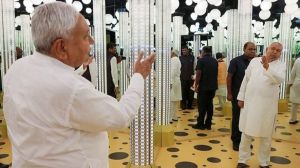Beauty in eye of a storm
Sandy Marie’s cellphone won’t stop ringing these days, and everyone who gets through has two questions. First: Are you okay? And t...

Sandy Marie’s cellphone won’t stop ringing these days, and everyone who gets through has two questions.
First: Are you okay?
And then: When can I come in to get my color done?
|
Hairdressers Natalie (left) and Sandy, at Natalie
& Friends Hair Studio in Long Beach, salve women’s dignity with hot water, fresh towels and scented candles. Clients just “kept coming in, sort of dazed, all of them asking me: ‘Are you really open? I need to get in now,’ ” Natalie says |
Marie understands; she’s been styling hair in the South for 28 years. It doesn’t surprise her that after women made sure their loved ones were safe, after they secured food and shelter, some of them longed above all for a cut and blow-dry.
Though they acknowledged that it seemed trivial in the aftermath of Hurricane Katrina, women browsed cosmetic counters at newly reopened stores, washed lingerie with their first load of laundry and scrambled to borrow appropriate shoes for church. They felt a deep need to look their best, they said, even while walking through devastated neighborhoods.
“It’s embarrassing to admit that I’m worried about how I look when so many people have died. But it’s not vanity. It’s our weapon against all this,” said Mary Jane Crosby, 45. “I just need to feel normal, and this helps, silly as it might seem.”
The few beauty salons that were open were booked solid. Among the shelves of shampoo and conditioner, women could talk and even laugh, and forget Katrina’s toll amid reassuring rituals of lathering and rinsing. All around them, the familiar had become the surreal. Amid such chaos, smoothing on a coat of lipstick didn’t feel like primping.
When residents from New Orleans were evacuated to the Houston Astrodome, they lined up until 4 a.m. to get their hair cut, colored and curled by volunteer stylists. “It’s a way to reclaim a sense of normalcy in an environment where absolutely nothing is normal,” said Amy Haulsee, 45, an obstetrics nurse.
The impulse to look good transcends boundaries of race, class and age. At a black church in Biloxi the first Sunday after the hurricane, Bernadette Warick, 54, lamented that she hadn’t found a hat to wear to Mass. The storm had nearly ripped the roof off Our Mother of Sorrows. The priest was using a lawn chair as an altar. Warick herself had lost everything she owned.
Still, she felt embarrassed that her head was bare. “I want things to be proper,” she said.
“This is a society that puts a great stress on etiquette, manners and performing roles,” said Charles Reagan Wilson, director of the Center for the Study of Southern Culture at the University of Mississippi.
Though this coastal town of 17,000 about 75 miles east of New Orleans took a heavy blow from Katrina, Natalie Schmidt’s strip-mall salon escaped with minimal damage. Most important, she had hot, filtered water, stacks of fresh towels and vanilla-scented candles to mask the smell of rotting garbage.
When Marie, a longtime friend, called to say that her salon had been destroyed — but that she had salvaged her scissors and a favorite curling iron — Schmidt asked her to come over and start working.
“Please come,” she said. “I think we’re going to be busy.”
Within the hour, the place was buzzing.
LAT-WP



- 01
- 02
- 03
- 04
- 05




























